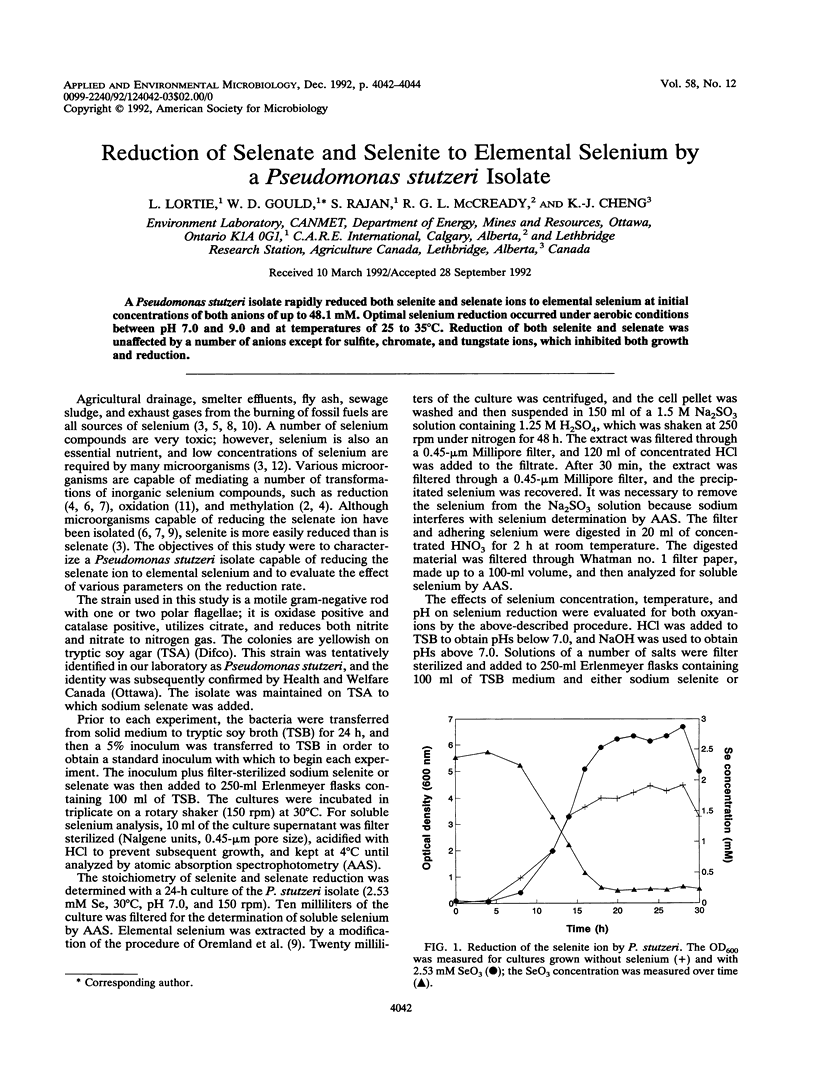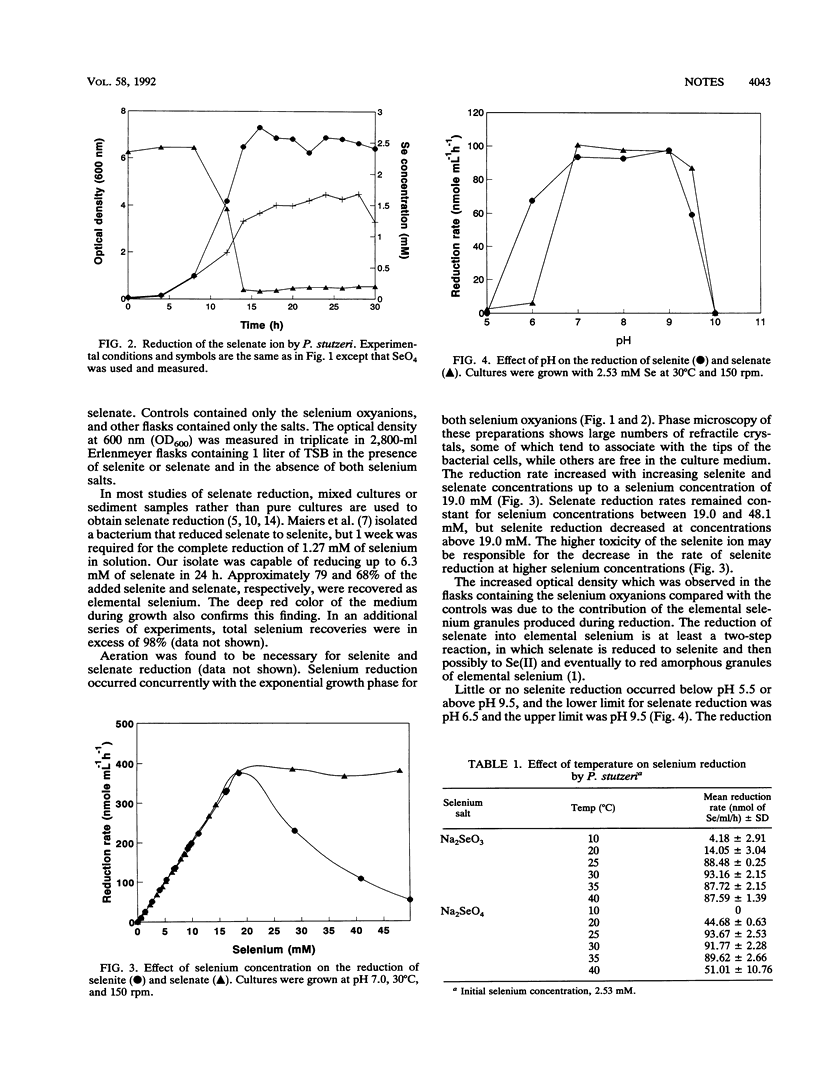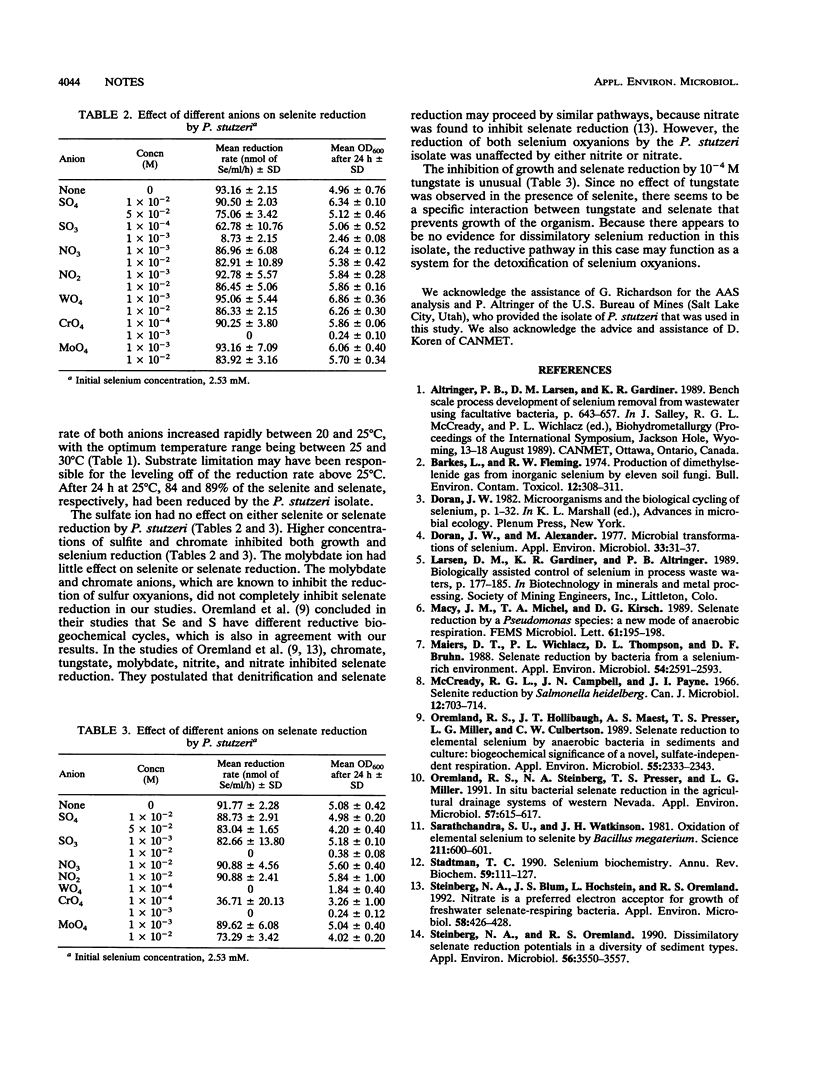Abstract
A Pseudomonas stutzeri isolate rapidly reduced both selenite and selenate ions to elemental selenium at initial concentrations of both anions of up to 48.1 mM. Optimal selenium reduction occurred under aerobic conditions between pH 7.0 and 9.0 and at temperatures of 25 to 35°C. Reduction of both selenite and selenate was unaffected by a number of anions except for sulfite, chromate, and tungstate ions, which inhibited both growth and reduction.
Full text
PDF


Selected References
These references are in PubMed. This may not be the complete list of references from this article.
- Barkes L., Fleming R. W. Production of dimethylselenide gas from inorganic selenium by eleven soil fungi. Bull Environ Contam Toxicol. 1974 Sep;12(3):308–311. doi: 10.1007/BF01709124. [DOI] [PubMed] [Google Scholar]
- Doran J. W., Alexander M. Microbial transformations of selenium. Appl Environ Microbiol. 1977 Jan;33(1):31–37. doi: 10.1128/aem.33.1.31-37.1977. [DOI] [PMC free article] [PubMed] [Google Scholar]
- Macy J. M., Michel T. A., Kirsch D. G. Selenate reduction by a Pseudomonas species: a new mode of anaerobic respiration. FEMS Microbiol Lett. 1989 Oct 1;52(1-2):195–198. doi: 10.1016/0378-1097(89)90195-x. [DOI] [PubMed] [Google Scholar]
- Maiers D. T., Wichlacz P. L., Thompson D. L., Bruhn D. F. Selenate reduction by bacteria from a selenium-rich environment. Appl Environ Microbiol. 1988 Oct;54(10):2591–2593. doi: 10.1128/aem.54.10.2591-2593.1988. [DOI] [PMC free article] [PubMed] [Google Scholar]
- McCready R. G., Campbell J. N., Payne J. I. Selenite reduction by Salmonella heidelberg. Can J Microbiol. 1966 Aug;12(4):703–714. doi: 10.1139/m66-097. [DOI] [PubMed] [Google Scholar]
- Oremland R. S., Hollibaugh J. T., Maest A. S., Presser T. S., Miller L. G., Culbertson C. W. Selenate reduction to elemental selenium by anaerobic bacteria in sediments and culture: biogeochemical significance of a novel, sulfate-independent respiration. Appl Environ Microbiol. 1989 Sep;55(9):2333–2343. doi: 10.1128/aem.55.9.2333-2343.1989. [DOI] [PMC free article] [PubMed] [Google Scholar]
- Oremland R. S., Steinberg N. A., Presser T. S., Miller L. G. In situ bacterial selenate reduction in the agricultural drainage systems of western Nevada. Appl Environ Microbiol. 1991 Feb;57(2):615–617. doi: 10.1128/aem.57.2.615-617.1991. [DOI] [PMC free article] [PubMed] [Google Scholar]
- Sarathchandra S. U., Watkinson J. H. Oxidation of elemental selenium to selenite by Bacillus megaterium. Science. 1981 Feb 6;211(4482):600–601. doi: 10.1126/science.6779378. [DOI] [PubMed] [Google Scholar]
- Stadtman T. C. Selenium biochemistry. Annu Rev Biochem. 1990;59:111–127. doi: 10.1146/annurev.bi.59.070190.000551. [DOI] [PubMed] [Google Scholar]
- Steinberg N. A., Blum J. S., Hochstein L., Oremland R. S. Nitrate is a preferred electron acceptor for growth of freshwater selenate-respiring bacteria. Appl Environ Microbiol. 1992 Jan;58(1):426–428. doi: 10.1128/aem.58.1.426-428.1992. [DOI] [PMC free article] [PubMed] [Google Scholar]
- Steinberg N. A., Oremland R. S. Dissimilatory selenate reduction potentials in a diversity of sediment types. Appl Environ Microbiol. 1990 Nov;56(11):3550–3557. doi: 10.1128/aem.56.11.3550-3557.1990. [DOI] [PMC free article] [PubMed] [Google Scholar]


